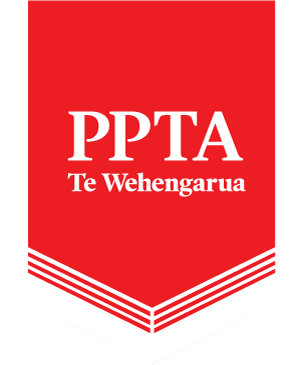Kāhui Ako
Kāhui Ako are also known as Communities of Schools or Communities of Learning. A Kāhui Ako is a group of schools approved to receive resourcing under the Investing in Educational Success (IES) initiative announced in 2014.
NZPPTA and Kāhuinga Manatōpu, the national Kāhui Ako Association, have signed a memorandum of understanding to work together to advance the goals of the Kāhui Ako initiative.

Documents
PPTA surveyed members about their experience and opinions of Communities of Learning. The survey report and the report to PPTA Annual Conference are below:
![]() Implementation of Communities of Learning – practitioners’ experiences (Survey report August 2017)
Implementation of Communities of Learning – practitioners’ experiences (Survey report August 2017)
![]() Communities of Learning: The slippage between planning and implementation (2017 Annual conference report)
Communities of Learning: The slippage between planning and implementation (2017 Annual conference report)
PPTA thanks the many members who contributed to the survey.
Kāhui Ako Responsibility allowances
From the start of 2024 kāhui ako schools have the option of converting some fixed term WST roles into more flexible allowances for:
i. promoting effective teaching practice within the school, and
ii. strengthening the use of effective approaches to teaching and learning to achieve shared Kāhui Ako objectives
iii. recognising Kahui Ako-related responsibilities undertaken by teachers (other than principals) who are not Kāhui Ako Teachers (within school).
Each Kāhui Ako Teacher (within school) role that is converted will provide:
i. Two Kāhui Ako Responsibility time allowances of 0.04 FTTE; and
ii. Four Kāhui Ako Responsibility salary allowances of $2,000
Advice on the requirements for using these allowances is in part 4.23 of the STCA and in the advice on the 2023-25 STCA settlement
The STCA and ASTCA require schools to make at least 60% of their within school teacher (WST) roles permanent.
In the joint guidelines from NZSTA, the Ministry of Education and PPTA (page 4) the three organisations have made clear that:
“if the school has three or more roles to allocate, each appointment to the role may be either permanent, or for a fixed-term in accordance with clause 3.2.3 of the STCA, provided that fixed-term appointments will never make up more than 40% of a board’s roles. There must be a genuine reason to appoint to a fixed-term.” (see the Guidelines for the appointment of the within school teacher role in Secondary Schools attached to this page)
This requirement is repeated as clause 4.24.5(a) of the STCA and 3.33.11 (b) (i) of the ASTCA.
If you are converting WST roles to Kāhui Ako allowances the requirement that 60% of allocated WST roles must be permeant includes the resourcing from converted roles.
Funding is on-going
Schools are reminded that the funding for Kāhui Ako positions is baseline (on-going) funding. If a school is required to reduce the number of permanent WST roles because of either a reduction in the number of roles they are entitled to, or because of a change in government policy the costs of reducing those roles will be met by the Ministry Education in the same way that the Ministry meets the costs of required staffing reductions.
The disestablishment processes for WST roles are contained in clauses 4.24.13 and 4.24.14 of the STCA and 3.33.8 of the ASTCA.
If you've been told your school is going to join a Kāhui Ako then be aware that you have a right to be consulted.
PPTA Te Wehengarua has developed advice in PowerPoint form for branch officers about being part of the Kāhui Ako consultative process (attached to the top of this page as a pdf).
Email ies@ppta.org.nz if you would prefer the PowerPoint version of "Developing a Kāhui Ako: Consultation with teachers."
- Transforming Education: The Impact of 110 Kāhui Ako 2024 NANP
- Ministry of Education - Community of Learning Guide to Writing a Memorandum of Agreement
- Ministry of Education - Community of Schools Tips and Starters: Working Together
- Ministry of Education - Community of Learning: Guide for Schools and Kura
- Ministry of Education - Community of Learning: Role Selection and Appointment Information
- Communities of Learning | Kāhui Ako: Collaboration to Improve Learner Outcomes (ERO, 2016)
- Communities of Learning | Kāhui Ako: Working towards collaborative practice (ERO, 2016)
- Communities of Learning | Kāhui Ako: The Emergent Stage (NZCER 2016)
Secondary Teachers' Collective Agreement provisions include:
STCA 2022 -2025 1.8 Definitions: “Kāhui Ako are also known as Communities of Schools and Communities of Learning. A Kāhui Ako is a group of schools approved to receive resourcing under the Investing in Educational Success initiative announced in 2014.)
STCA 2022 - 2025 3.2.2 Advertising and Appointment
STCA 2022 - 2025 Part Three: Community of Schools-level induction and networking programmes (see 3.8D)
STCA 2022 - 2025 Part Four: Remuneration - Acting Principal (see 4.15.2), Acting in a Higher Position other than Principal (see 4.16.3 and 4.16.4), Allowances (see from 4.22, 4.23, 4.24)
STCA 2022 - 2025 Part Five: Hours of Work (5.1.1) Inquiry Time (5.2.7)
STCA 2022 - 2025 Part Four : (4.24) Kāhui Ako Responsibility allowances
Area School Teachers' Collective Agreement provisions include:
ASTCA 2022 - 2025 Part Two - Terms of Employment: Advertising and Appointments (2.2.2), Community-level Induction and Networking Programmes (see 2.20)
ASTCA 2022- 2025 Part Three - Remuneration: Allowances (see 3.31-3.33), Acting or Relieving Principals (3.11.3), Acting in a Higher Position (other than as Principal) (3.12.4)
ASTCA 2022 - 2025 Part Four - Hours of Work: (4.1.1), Inquiry Time (4.2.6).
Useful resources:
![]() Communities of Learning | Kāhui Ako: Collaboration to Improve Learner Outcomes (ERO, 2016)
Communities of Learning | Kāhui Ako: Collaboration to Improve Learner Outcomes (ERO, 2016) ![]() Communities of Learning | Kāhui Ako: Working towards collaborative practice (ERO, 2016)
Communities of Learning | Kāhui Ako: Working towards collaborative practice (ERO, 2016)
![]() Ministry of Education - Community of Learning Guide to Writing a Memorandum of Agreement
Ministry of Education - Community of Learning Guide to Writing a Memorandum of Agreement
![]() Ministry of Education - Community of Schools Tips and Starters: Working Together
Ministry of Education - Community of Schools Tips and Starters: Working Together
![]() Ministry of Education - Community of Learning: Guide for Schools and Kura
Ministry of Education - Community of Learning: Guide for Schools and Kura
![]() Ministry of Education - Community of Learning: Role Selection and Appointment Information
Ministry of Education - Community of Learning: Role Selection and Appointment Information
![]() Communities of Learning | Kāhui Ako: The Emergent Stage (NZCER 2016)
Communities of Learning | Kāhui Ako: The Emergent Stage (NZCER 2016)
Last modified on Wednesday, 11 June 2025 15:03
